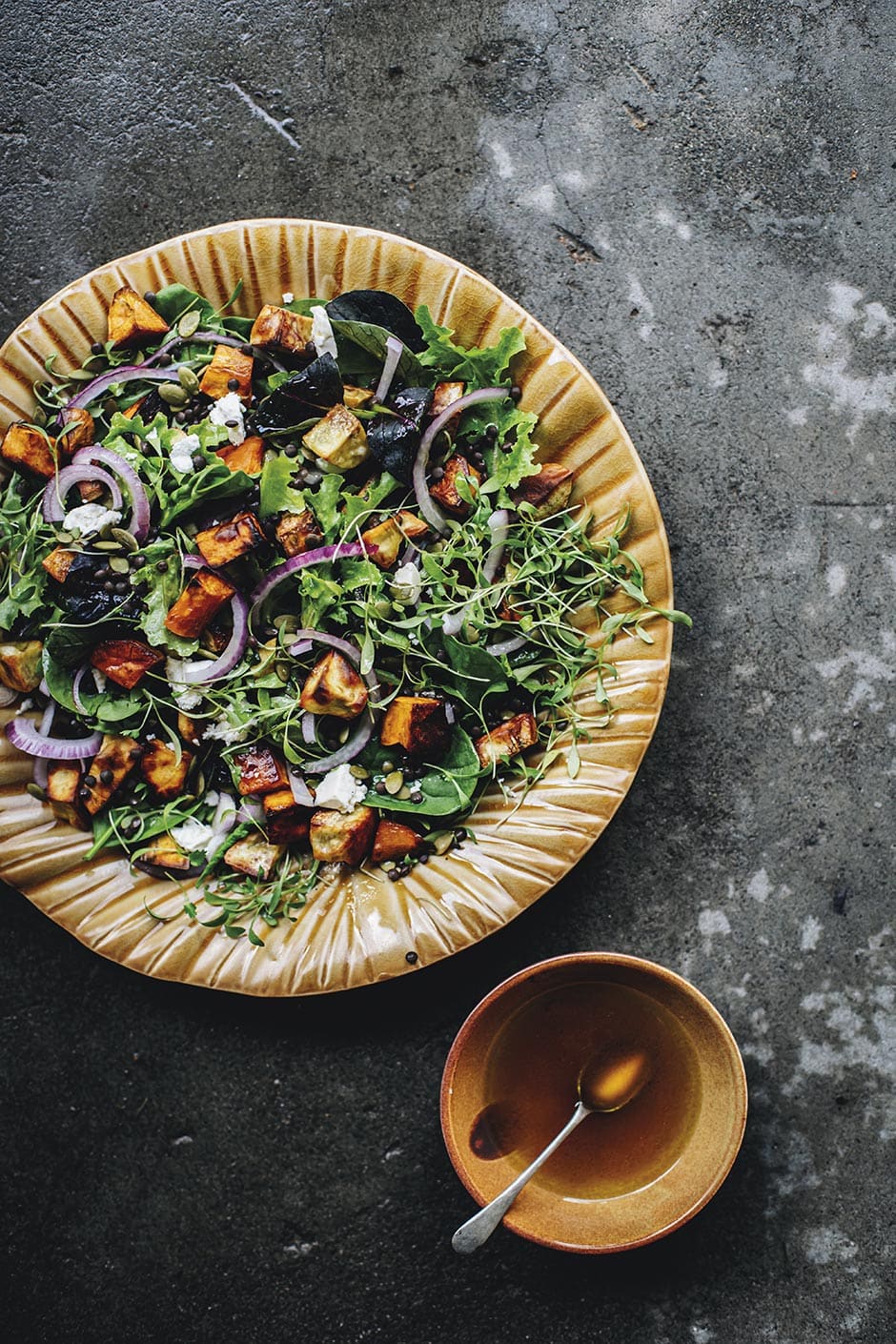Food has always been a big part of Manawatū food stylist, photographer, cook, recipe developer, artist, entrepreneur and mum Christall Lowe’s life. In her first, fantastic book, Kai, she goes back to the beginning of a flavoursome journey that began on her nana’s lap with a revelatory mouthful of mashed kamokamo…

“Too young to walk or talk, I’m sure that first meal set me up for a life of loving good, homegrown kai — and butter. Food has always been a huge part of our family life. ‘Good kai’, as Grandad would say. Kai is a book about our way of cooking, eating and gathering — whether it be the gathering of kai or the gathering of people. Our ‘life of kai’.
“Our life of kai is something innate, because it’s an extension of our very person — how we were raised, the concepts and ideologies that have been worked into our core simply through nurturing. The way my nana did things was the way her nana did things. The respect we have for food and the land comes not just from the knowledge of tapu (sacred, prohibited, restricted, set apart, forbidden) and noa (to be free from the extensions of tapu; ordinary, unrestricted) that has been imparted to us, but from the desire to be self-sufficient, to grow our own, to live gently off the land and sea while being responsible for it as kaitiaki, as guardians.”

Kūmara & lentil salad
Serves 4 as a side
This salad is a firm family favourite, and one my mum has been making for years with different variations. The sweetness of the kūmara with the saltiness of the feta and the sourness of the dressing is a beautiful thing.
2 medium-sized purple or orange kūmara (about 500g)
3 tablespoons neutral oil (e.g. canola)
½ cup black (beluga) lentils
2 cups water
4 cups mixed mesclun salad leaves and microgreens
¼ cup pumpkin seeds
½ red onion, sliced
100g feta cheese
For the dressing
2 tablespoons runny honey
¼ cup olive oil
2 tablespoons cider vinegar
Heat the oven to 180°C. Peel the kūmara and chop it into small cubes, then place it on a baking tray with sides or in a roasting dish, drizzle with oil and bake for 20–25 minutes, turning once or twice during cooking. You want it to be golden and well roasted.
Rinse the lentils under running water, then place them in a medium-sized saucepan with the water. Bring to the boil, cover with a lid, reduce the heat and simmer for 15–20 minutes until tender.
Drain off any remaining water and set aside.
Prepare the dressing by shaking all of the dressing ingredients together in a lidded jar.
To assemble the salad, lay the greens in a large serving dish, then spread all of the other ingredients evenly over them. Drizzle the dressing over the top and toss lightly to combine.

Mamacita spicy chicken
Serves 4
Everyone loves Mama’s spicy chicken wings in my household, so much so that they’ve been dubbed mamacita (aka ‘hot mama’) chicken! A simple, no-fuss marinade is what it’s all about, and leaving those flavours to infuse makes the chicken even more tasty and tender. These can be served as a main with rice or potato wedges, or on a platter with dipping sauces. You’ll need to start making them at least two hours in advance, if not the day before, to allow time for marination.
1kg chicken nibbles or wings
4 cloves garlic, finely chopped
1 small knob fresh ginger, finely chopped
¼ cup honey or pure maple syrup
¼ cup barbecue sauce
¼ cup soy sauce
1–2 teaspoons chilli sauce
2 spring onions, finely chopped
Place the chicken pieces in a medium-sized bowl. Mix the garlic, ginger, honey, barbecue sauce, soy sauce and chilli sauce in a small bowl, pour over the chicken and mix to coat thoroughly. Cover and leave to marinate in the fridge for 2 hours or overnight.
When ready to cook, heat the oven to 180°C. Spread the chicken pieces over a large baking tray with sides, or a roasting dish, and cook for 45 minutes to an hour, turning twice during cooking until they’re golden and cooked through.
Sprinkle with the chopped spring onions and serve as a main dish with rice or potatoes and a slaw, or as nibbles with dipping sauces.

Golden queen sponge
Serves 6
I have a vivid childhood memory of seeing rows and rows of jars full of plump Golden Queen peaches in the pantry. I can still smell the aroma of peaches cooking in the big pot on the stove, and fogged-up windows when I came home from school were a sure sign that Mum was bottling. If you don’t have a pantry full of bottled peaches for this recipe, don’t despair. Store-bought canned peaches work just as well, or change it up and use berries, feijoas, pears or rhubarb. The sponge is soft, light and buttery, just like Nana made.
3–4 cups (about 600g) bottled or canned peaches, drained and chopped
3 tablespoons brown sugar
¼ cup boiling water
125g butter, softened
1 teaspoon pure vanilla extract
½ cup white sugar
2 eggs
1 cup plain flour
2 teaspoons baking powder
2 tablespoons milk
Icing sugar, to dust
Heat the oven to 190°C. Place the fruit in a medium-sized ovenproof baking dish then into the oven to heat for 10 minutes.
Mix the brown sugar and boiling water together in a cup until the sugar is dissolved. Set aside. In a large mixing bowl, cream the butter, vanilla and white sugar with an electric beater until pale and creamy. Add the eggs one at a time, beating well after each addition.
Sift the flour and baking powder into the bowl, then fold into the creamed mixture. Add the milk and mix until just combined.
Spoon the mixture over the hot fruit, pour the brown sugar syrup over the top, then bake for 30–35 minutes or until the sponge is golden and springs back when lightly touched.
Dust with icing sugar and serve warm with cream, ice-cream or custard — or all of the above.

Banana & tahini caramel on toast
Makes about ½ cup
This fancy but oh-so-simple version of peanut butter on toast is not only delicious, it’s good for you. Use unhulled tahini for a gorgeous caramel colour and thicker consistency, and feel free to omit the cinnamon if you don’t fancy it. You’re gonna want to drizzle tahini caramel on everything after trying this decadent, no-cook, dairy-free sauce — porridge, overnight oats, kūmara wedges and banana bread, to name a few possibilities — and it’s also great for dunking apple slices into.
2 tablespoons avocado oil or olive oil
¼ cup unhulled tahini
3 tablespoons pure maple syrup
½ teaspoon ground cinnamon
1 pinch salt
To serve
Nut butter of your choice
Sliced banana
Toast of your choice
Sesame seeds (optional)
Combine the caramel ingredients together in a small bowl and mix until smooth. If it’s too thick to drizzle, add a little water 1 teaspoon at a time until you reach the desired consistency.
Drizzle the tahini caramel over nut butter and banana on toast, and sprinkle with a few sesame seeds if you like.
 Edited extract from Kai: Food Stories & Recipes From My Family Table by Christall Lowe (Bateman Books, $60).
Edited extract from Kai: Food Stories & Recipes From My Family Table by Christall Lowe (Bateman Books, $60).
Words & photography (Ngāti Kauwhata, Ngāti Maniapoto, Rata whānau)
Christall’s portraits
The post appeared first on .





























